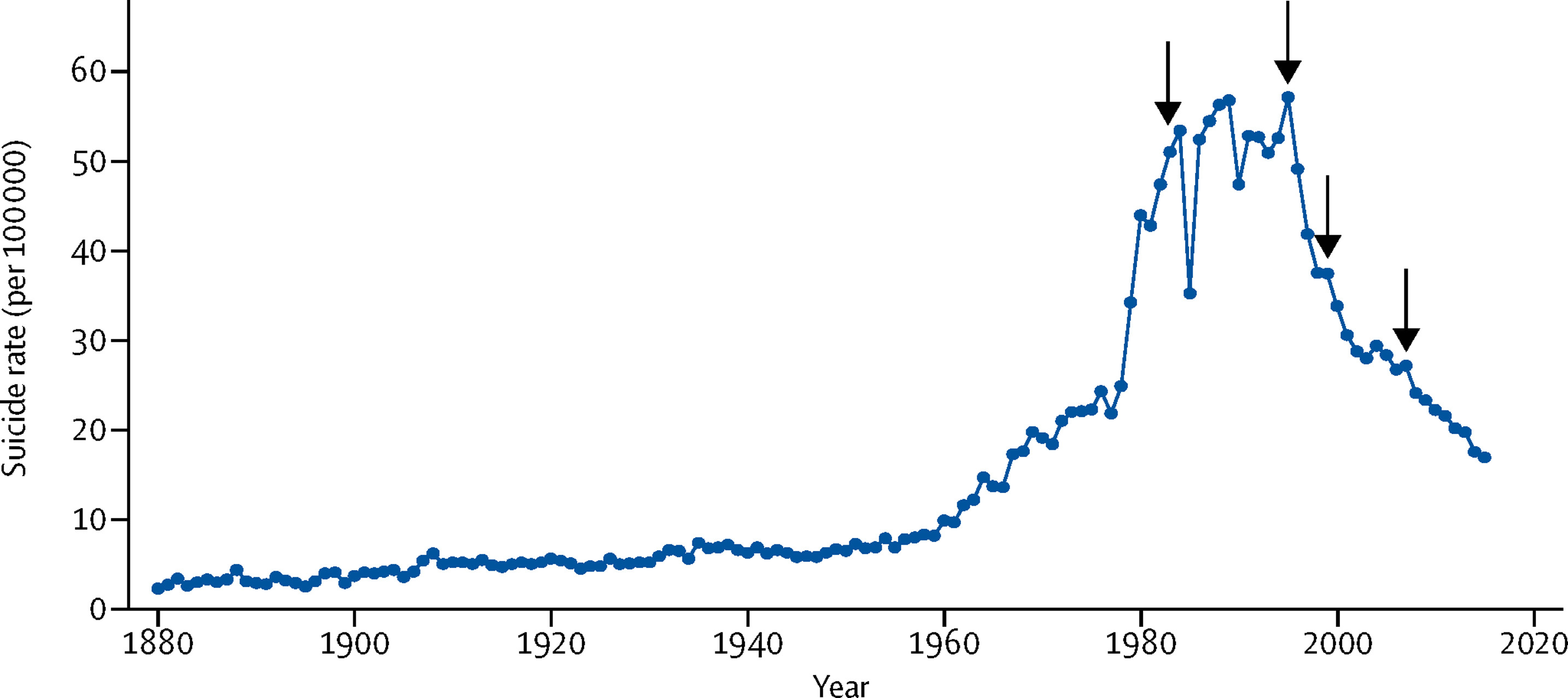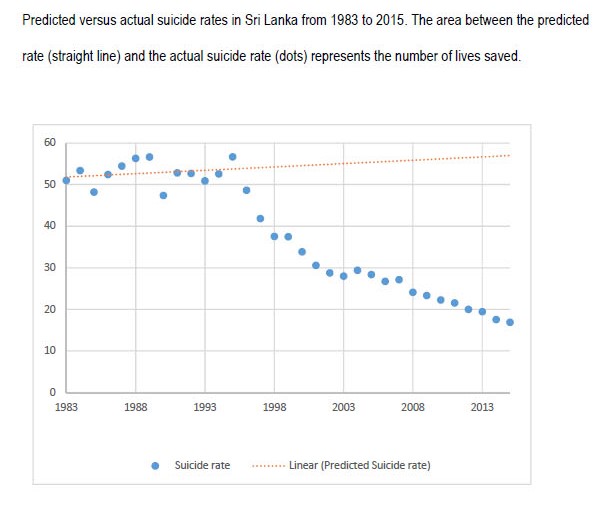Featured image courtesy Sumithrayo.org
Editor’s Note: This post contains discussion on the topic of suicide. If you feel you may want to take your own life, or are concerned about someone else who is likely to attempt suicide, talk to Sumithrayo (when dialling from within Sri Lanka, phone: 011 269 6666)
The World Health Organisation (WHO) estimates that close to 800,000 people die by suicide each year, with the majority of deaths occurring in low-income and middle-income countries. Many more attempt suicide. Suicide accounted for 1.4% of all deaths worldwide, making it the 17th leading cause of death in 2015. While this makes grim news, WHO also says that effective and evidence-based interventions can be implemented at population, sub-population and individual levels to prevent suicide and suicide attempts.
In recent years, mainstream and social media coverage around suicide has created an impression that Sri Lanka’s suicide rate is rising rapidly. Sections of the media have begun calling Sri Lanka the ‘suicide capital’ of the world. Others are quick to blame new technologies such as social media as the ‘cause’ for some recent youth suicides, without any research to back such claims.
There is no doubt that suicides are a major issue in Lankan society. It warrants a response at policy, institutional and community level. But first, we need to better understand the magnitude of the problem and the factors involved.
Sadly, public discourse is dominated by media hype, activist rhetoric and misconceptions instead of data-driven analysis. Even WHO, which sets global standards for public health analyses and responses, has erred in this regard. In September 2014, WHO’s first global report on suicide wrongly identified Sri Lanka has having the fourth highest suicide rate in the world (28.8 deaths per 100,000 according to them). That rate was modelled using data that was eight years out of date, i.e. the last national data submission made in 2006.
Duleeka W. Knipe, then a PhD researcher at the University of Bristol, UK, who has studied this topic in-depth, questioned WHO’s analysis. She went in search of actual records, and studied suicide data from Sri Lanka Police Department’s statistics division. She found that there had been 2,644 fewer suicides in 2012 than had been estimated by WHO using the 2006 data. When she used the more recent data, it reduced the annual suicide estimate by a quarter, and the country’s suicide rate came down to 17.1 per 100,000. That fresh analysis, which she published in several medical journals, repositioned the island nation at 22nd in global rankings for suicides. [Yet, regrettably, WHO’s erroneous calculation persists in the public domain and is still frequently cited by journalists and activists.]
Today, Dr Duleeka Knipe is a mental health epidemiologist at the Bristol Medical School, part of the University of Bristol. She has trained in public health, pathology and microbiology. Her research work has investigated the association between social factors and suicidal behaviour in low and middle income countries in South and South-East Asia. She has 7 years of experience in researching suicide and self-harm in Sri Lanka. Duleeka has published widely on the national suicide statistics in Sri Lanka and on her work as part of a large longitudinal study (200,000+ individuals in 54,000+ households) in the North Central Province.
In recognition of her work on suicide prevention in Sri Lanka, she has been awarded the prestigious International Association of Suicide Prevention Andrej Marusic Award (2017), and an Economic and Research Council Research Fellowship to continue her work. Duleeka also chairs the University of Bristol’s Suicide and Self-Harm group.
The following are excerpts from an interview, conducted via email:
Suicides are the tragic outcome of complex human, socio-economic and societal factors. In view of this, how difficult is it to determine a specific causative factor?
Determining what causes a specific health outcome is very difficult because it is rare to be able to identify a single factor. This is particularly so for suicide. Usually there is no single cause, but a cumulation of factors which increases an individual’s vulnerability to suicide. There are, however, some clearly recognised factors that increase an individual’s risk of suicide — for example debt, job loss, a relationship breakdown, bullying, and alcohol misuse. These factors may interact with pre-existing vulnerabilities (such as mental health issues) to increase the risk of suicide.
How do researchers deal with this multifactorial reality when they want to discern the more probable causes or factors that triggered suicidal action in a given case?
As researchers, we would focus on two approaches. Firstly, a multivariate analysis, i.e. analysis that takes account of other factors to enable use to look at the specific impact of a risk factor we are investigating. Secondly, time series approaches, i.e. looking at the rate of suicide over time and how it changes in response to environmental or social shocks, e.g. economic recessions, pesticide bans or restrictions by government, etc.
If we want to investigate individual suicide deaths, then the tool most commonly used is a psychological autopsy. Using this method we would collect information on the deceased via interviews with family members, friends and other relevant individuals. Where available, detailed information will also be collected from health records. It is a comprehensive method to try to detail the factors which would have contributed to the suicide death. This method, however, relies on third party reports of why the deceased decided to kill themselves and therefore might be biased (especially if there are no supporting medical records, which is often the case in Sri Lanka).
Which official source of data is most widely used by researchers studying suicides in Sri Lanka – hospital records or police records? How comprehensive is the recording of suicide cases in the country? Are there gaps or under-reporting?
Suicide researchers in Sri Lanka often use the Department of Police data, as it is collected nationally and many deaths by suicide occur in the community rather than in hospitals (the exception is deaths by self-poisoning, but these now comprise less than 30% of all suicide deaths). The quality of the suicide data in Sri Lanka is unlikely to have changed over time, but to the best of my knowledge, there have been no research studies which have explicitly investigated whether there are cases of under-reporting in the police statistics.

Incidence of suicide in Sri Lanka, 1880–2015. Arrows show timing of pesticide bans between 1984 and 2008
At national level in Sri Lanka, is there any systematic and on-going attempt to monitor and understand the various factors that contribute to suicides? Which institutions or individuals are involved in such monitoring?
Several studies have investigating trends (and factors influencing trends in suicide) over the last few decades. There are several groups in Sri Lanka and in other Universities around the world who have been investigating this. The research in this area has involved scholars from several different disciplines, which highlights the fact that suicide behaviour is difficult to investigate given its complexity.
From a population health science point of view, I have been investigating the factors that contribute to suicide in Sri Lanka for 7 years and I am continuing to monitor the national suicide rate. In addition, by using large scale survey data from the North Central Province, I’ve been investigating the association of different social factors with suicide behaviour.
Sri Lanka has experienced major changes in its suicide rates since the 1970s, and by 1995 it had one of the highest rates in the world. Where does it rank today in terms of the annual, cumulative number of suicides?
To effectively rank countries in order of their suicide rate, you would need to have accurate data on suicide globally. This is simply not the case, especially in low and middle income countries, where the surveillance systems for suicide are not robust. Comparisons therefore are difficult and should be avoided given that we are not comparing like for like.
What I can say is that Sri Lanka has made major advances in reducing its suicide rate from the peak in the mid 1990s when there were over 8514 reported suicide deaths (1995).
This has now come down significantly: there were 3,025 suicide deaths reported in 2016. Compared to neighbouring South Asian countries, where there has been little change in suicide rates, Sri Lanka has managed to reduce its crude suicide rate by 70% during the last two decades.
This is a major public health accomplishment that is not widely known or appreciated. What specific policy or regulatory measures helped bring down suicide rates in Sri Lanka?
Research indicates that the major contributor to the reduction in suicide in Sri Lanka appears to have been the removal/bans on the sale and import of the most toxic pesticides in the country. This removal has resulted in dramatic declines in the number of people dying by suicide.
As two fellow researchers and I wrote in The Lancet Global Health medical journal in July 2017, “Sri Lanka’s pesticide regulations appear to have contributed to one of the greatest decreases in suicide rate ever seen. Having peaked at 57 per 100,000 people over 8 years in the early 1990s, its incidence is now 17 per 100,000 each year, a 70% reduction, and continuing to fall.”
In that paper, we estimated that the pesticide regulatory action alone resulted in 93,000 Sri Lankan lives being saved between 1995 and 2015. The annual costs for the Office of the Registrar of Pesticides in the early 2000s was about USD 200,000. Considering only direct costs, each life was therefore saved at a cost of USD 43. [Full paper: Preventing deaths from pesticide self-poisoning—learning from Sri Lanka’s success. Duleeka W Knipe, David Gunnell, Michael Eddleston. The Lancet. Volume 5, No. 7, e651–e652, July 2017: http://www.thelancet.com/journals/langlo/article/PIIS2214-109X(17)30208-5/fulltext]

Predicted versus actual suicide rates in Sri Lanka from 1983 to 2015 (suicide deaths per 100,000 population)
What unfinished business remains on this front? I mean, what more needs to be done by government, medical profession, community organisations and others to further reduce suicides?
While the number of people dying by suicide has dramatically reduced in Sri Lanka, there are still large numbers of people making suicide attempts, indicating that there is a level of distress being experienced by the population which needs to be addressed. In addition, Sri Lanka still has a high suicide rate in young people (twice that of high income countries). Given that many factors contribute to suicidal behaviour, a multisector approach is needed to counter this trend. This approach, however, needs to properly co-ordinated. Some of my own work has highlighted the need for developing life skills (relationship and budgeting), reducing alcohol misuse, as well as the state and society providing improved mental health services and better awareness.
Your research papers in recent years have concluded that “The epidemiology of suicide in Sri Lanka has changed noticeably in the last 30 years.” Is this widely known or understood by our policy makers, public health professionals or journalists? If not, what can be done to raise awareness about changing patterns?
Based on my dealing with policy makers and public health professional there is a general awareness within these circles that the suicide rate in Sri Lanka has changed over time. However, the articles I read in the Lankan media about suicide use information and analysis that are somewhat outdated. This is partly due to journalists and even mental health activists not always having the latest data available to them. Part of my work over the next few months is to ensure that relevant stakeholders (e.g. government, UN and NGOs) have the most up to date data.
Attributing several suicides to the current prolonged drought in Sri Lanka, as claimed by the UN Resident Coordinator, was questioned and challenged by some of us from the moment they issued their contentious September 19 statement. UN recanted their claim on September 28 saying “…they (suicides) cannot directly be attributed to the effects of the drought.” We know that the UN is not equipped to do primary research, but in this instance did they exceed their remit?
I have no detailed specialist knowledge of the official role of the UN. However, what is important to keep in mind is that suicide is a complex behaviour, and we should avoid oversimplifying what causes someone to take their life. There will be many who experience an exposure, for example the drought, who do not take their lives. As I previously mentioned, causality is very difficult to ascertain, and requires the right data and methods to investigate it. As far as I am aware there is no research evidence from Sri Lanka suggesting that the drought has contributed to an increased risk of suicide.
It is worth noting, though, that whilst there is no research evidence from Sri Lanka, there is some work in Australia that has linked periods of drought to increased suicide (Example: https://www.ncbi.nlm.nih.gov/pmc/articles/PMC3435226/
In your view, how best can development and humanitarian organisations document, analyse and discuss suicides?
A better link with active researchers in the field of suicide would be of benefit to the organisations but also to us as researchers. We are always looking for ways to engage with organisations to make sure that accurate data are used when reporting about suicide and in the ways that suicide is discussed. But it is also important to note that there is strong evidence that media reporting of suicides can, sometimes, adversely impact on suicide rates and so any discourse must be handled carefully.
This is not the first time that a UN agency created some confusion about suicides in Sri Lanka. In September 2014, you as a young researcher pointed out that the calculations for Sri Lanka in WHO’s first global report on suicides were based on data that was several years outdated. What happened?
The WHO suicide prevention report is an important document and has been useful for many who want to get an overview of suicide globally. The report utilised data that was submitted to them by country offices to calculate the suicide rate in 2012. If the data were out of date then WHO projected the number of deaths they would expect to see, based on previously submitted data. Sri Lanka had not submitted the most up to date statistics on suicide to WHO and this resulted in an incorrect estimation.
The WHO report did caution users of the report, that the data may not be accurate. My article pointing out the inaccuracy of the WHO reported suicide rate was aimed at those who would use the report (i.e. media, NGOs and other groups in Sri Lanka) to ensure that they took heed of the warning about the accuracy of the statistics.
What are your impressions of how the Lankan media reports on suicides – both on specific incidents, as well as in discussing overall trends?
I have read numerous articles and watched several television news reports on suicide in Sri Lanka and have been distressed by the manner in which suicide deaths are both portrayed and reported. The media have a major role to play in suicide prevention. Evidence has shown that certain types of media depictions of suicide can lead to imitative behaviour and result in increases in the number of suicides. Vulnerable people (e.g. young people, those experiencing various difficulties) may be more likely to over-identify with the suicide victim. There is a study that is due to come out by colleagues from the University of Copenhagen who have recently conducted a study of media (print) reports of suicide.
As to the trends of suicide, I am disheartened to see that the media in Sri Lanka still continue to use the above mentioned WHO report for statistics on suicide deaths in our own country. I hope that my efforts in sharing the suicide statistics with relevant groups in the country will help ensure more accurate reporting.
How does the media in the UK, where you live and work, observe ethical and humane considerations when reporting on suicides? What can Lankan media learn from this?
The media in the UK are encouraged to adhere to a set of guidelines set out by the Samaritans, a UK charity, which are closely related to WHO’s media guidelines titled Preventing Suicide: A Resource for Media Professionals (2008). In fact, WHO and the International Association for Suicide Prevention (IASP) have just released a new version in October 2017. So ethical guidance is available to anyone looking for it.
Many media outlets in the UK recognise the importance of sensitive suicide reporting. The Sri Lankan media could adopt a similar strategy when reporting on suicide deaths by ensuring that they adhere to a set of basic guidelines.

